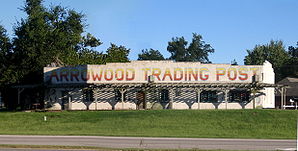Catoosa, Oklahoma
| Catoosa | ||
|---|---|---|
 The Blue Whale from Catoosa |
||
| Location in Oklahoma | ||
|
|
||
| Basic data | ||
| Foundation : | 1891 | |
| State : | United States | |
| State : | Oklahoma | |
| Counties : |
Rogers County Wagoner County |
|
| Coordinates : | 36 ° 11 ′ N , 95 ° 46 ′ W | |
| Time zone : | Central ( UTC − 6 / −5 ) | |
| Residents : | 5,449 (as of: 2000) | |
| Population density : | 302.7 inhabitants per km 2 | |
| Area : | 18.1 km 2 (approx. 7 mi 2 ) of which 18.0 km 2 (approx. 7 mi 2 ) are land |
|
| Height : | 190 m | |
| Postal code : | 74015 | |
| Area code : | +1 918 | |
| FIPS : | 40-12900 | |
| GNIS ID : | 1091043 | |
| Website : | www.cityofcatoosa.org | |
| Mayor : | Rita Lamkin | |
 Arrowood Indian Trading Post |
||
Catoosa is a small town in the US state of Oklahoma . The place belongs to both Rogers County and Wagoner County . In 2000 there were 5449 inhabitants. Catoosa is 14 miles northeast of Tulsa and is part of the economic catchment area of the second largest city in the state of Oklahoma. It is home to the Tulsa Port of Catoosa , the most inland inland port in the United States . It connects Tulsa with the Gulf of Mexico via the Arkansas River . Catoosa is located directly on a well-preserved section of historic Route 66 .
history
The city's name is borrowed from the Cherokee language, and is originally pronounced "Ga-du-si" or "Ga-tu-si" . It means something like "between two mountains" or "on" or "in the mountains". The Cherokee people colonized the region well into the second half of the 19th century . In the years 1881-82 the Atlantic and Pacific Railroad Railway Company and finally the St. Louis and San Francisco Railway built rail connections to Catoosa. The place quickly became an important transshipment point for livestock that was transported to the east coast .
The Catoosa Post Office was opened in 1883 . In 1900 the population was 241. There were numerous shops, two doctors, two blacksmiths, a hotel, a law firm and numerous cattle dealers. In 1911 the place got a bank, a mill, a fashion store and a stonemason. Three newspapers appeared, the Catoosan , the Catoosa Courier , and the Catoosa Star . Coal mining soon became a major economic factor.
In the 1940s and 1950s, travelers on Route 66 became another major source of income. The Arrowood Indian Trading Post rest stop is a holdover from that time. In 1971 the city experienced a boom with the opening of the inland port ( Port of Catoosa ) by US President Richard M. Nixon .
The blue whale of Catoosa
Another landmark was erected on Route 66 in the early 1970s . The Blue Whale ( Blue Whale ) of Catoosa was part of a small private amusement parks, the Animal and Reptile Kingdom . Originally, the owner only built the whale as a gift for his wife. Due to the great interest it became an amusement park. In 1988 it was closed and the Blue Whale fell into a deep slumber. In the course of Route 66 nostalgia, it received attention again and was restored from 1996.
literature
- Michael Wallis: Route 66: The Mother Road, Griffin (2008) ISBN 0-312-28161-7 .
- Holger Hoetzel: Route 66: Straße der Sehnsucht , Ullstein; (1992) ISBN 3-550-06558-2 .
- Tom Snyder: Route 66: Traveler's Guide and Roadside Companion Griffin (2000) ISBN 0-312-25417-2 .



